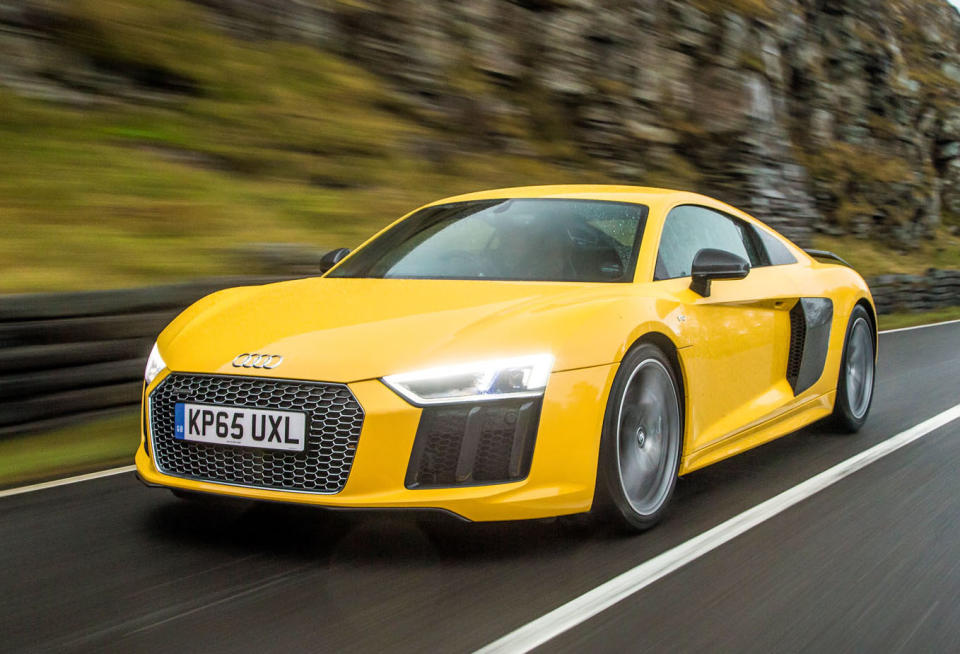Audi R8

The Audi R8 did not build the brand. The formidable glaze coating of Ingolstadt’s reputation was baked long before it indulged an impulse to make a bona fide mid-engined sports car.
But when it did, when the result proved exceptional and exciting and idiosyncratic, it was concrete evidence that Audi was indeed capable of almost anything.
Just as it had reeled in the huge lead that greater longevity had given BMW and Mercedes-Benz, so it might now compete with the mighty Porsche.
The R8, in its original V8 format, was an automotive attestation of the boldest sort: the Porsche 911’s status is not sacrosanct and that firm's path to driving nirvana isn’t the sole means of ascent.
Quattro GmbH had conceived of another way and Audi rallied the ambition, expertise and investment required to make it happen.
Now, nine years on from the original R8’s introduction, it has retooled for a second run, tweaking much in a car whose design clearly continues to owe a substantial debt to the look of its predecessor. Its reason for being is slightly different, though.
Porsche has gone from rival to relative, and so the requirement for a more modest V8-powered variant to challenge the Carrera has gone, too.
Consequently, Audi’s 5.2-litre V10 – still naturally aspirated – has become the only engine choice and £119,500 has become the starting price.
So the R8’s positioning has changed slightly, from sports car to super-sports car – and the move has been a long time coming. It was previewed by the phalanx of more and more powerful run-out special editions of the previous R8 but was ultimately hinted at much earlier, when Audi learnt how much buyers were prepared to pay for the R8.
We’re testing the quickest, most expensive version: the Audi R8 V10 Plus, delivering the same 602bhp as its Lamborghini Huracán sibling. It is, in fact, the quickest car Audi has made. Now, to properly succeed its predecessor, it just has to be the best driver’s car Audi has made, too.
Audi R8 design & styling
The new R8 is, Audi claims, the closest thing to a racing car that it has ever attempted to make for the road.
The original car’s manual gearbox and V8 have been consigned to history – something we regret in both cases – and replaced by an engine range consisting of 533bhp and 602bhp 5.2-litre V10 options and a seven-speed dual-clutch S tronic ’box. For those seeking to make that evocative V10 more vocal, there is the option to have the 533bhp in Spyder form.
The changes to the mixed-metal V10 are legion, among them a hike in compression ratio, a new fuel injection system with both direct and indirect delivery, and the adoption of cylinder shutdown.
With an under-square design, offset cylinder banks and alternating firing intervals for opposing cylinders of 54deg and 90deg, the engine remains unconventional for its type. But that type remains one of atmospheric aspiration, with peak power developed north of 8000rpm, peak revs close to 9000rpm and what Audi hails as a 20 percent improvement in throttle response.
The car’s Audi Space Frame underbody, shared with the Huracán, is now five percent lighter than it used to be and 40 percent more rigid, gains delivered by mixing aluminium castings, extrusions and sheets with resin-transfer-moulded, carbonfibre-reinforced polymer parts. All external body panels are aluminium.
Audi’s kerb weight claim for the higher-output V10 Plus is 1555kg, but MIRA’s weighbridge put our test car – fitted with more than £10,000 of optional kit, admittedly – at 1730kg, a figure that would suggest some discipline may be required during the ordering process if you want your R8 to really benefit from Audi’s engineering effort.
The R8’s running gear consists of axle tracks that are wider up front than at the rear, aluminium double wishbones all round and – in the case of the V10 Plus – slightly stiffer springs and passive dampers than the outgoing car had, matched to forged 19in alloy wheels.
The standard steering set-up moves from electro-hydraulic to electro-mechanical power assistance. On the options list are both adaptive magnetorheological dampers and active-ratio dynamic steering – both of which our test car had fitted.
Finally, Audi’s trademark quattro drivetrain for the R8 is now made up of a mechanical limited-slip differential for the rear axle (locking up to 45 percent under power and 25 percent on the overrun), and a multi-plate clutch packaged inside the front differential that’s capable of apportioning more power to the front wheels than the previous viscous coupling could and reacting more quickly.
]]>

 Yahoo Autos
Yahoo Autos 